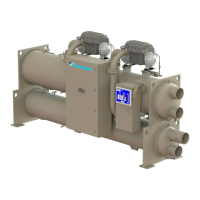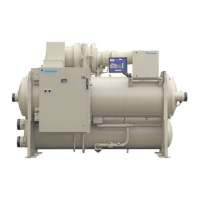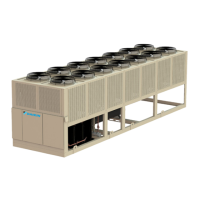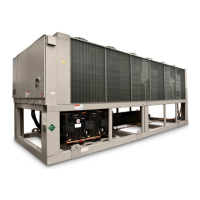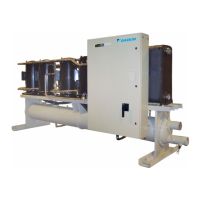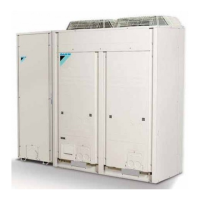OPERATION
NAVIGATOR WWV/TWVDAIKIN APPLIED
40
Oil Return Solenoid Valve
The oil return solenoid valve output should be on whenever the
compressor is being commanded to run. This output activates the
oil return solenoid valve as well as the jet pump solenoid valve.
Circuit Capacity Overrides
The following conditions override automatic capacity control
as described. These overrides keep the circuit from entering a
condition in which it is not designed to run.
High Water Temperature Capacity Limit
If the evaporator LWT reaches 25°C (77°F) or higher, then high
evaporator loop temperature capacity limits will be in eect.
When high evaporator loop temperature capacity limits are
in eect and the capacity is 80% or higher, the circuit will not
increase in capacity.
When high evaporator loop temperature capacity limits are in
eect and the capacity is higher than 85%, the circuit capacity will
be reduced until it is at 85% or less.
High evaporator loop temperature capacity limits will no longer
be in eect when evaporator LWT is less than 25°C (77°F) for at
least a minute.
Low Discharge Superheat Capacity Limit
If DSH < Minimum DSH set point, unit mode is Cool, and the
compressor speed = 35 Hz, the compressor will not be allowed to
increase speed.
If DSH < Minimum DSH set point, unit mode is Cool, and the
compressor speed > 35 Hz the compressor speed will be
reduced until it is at 35 Hz or lower.
The above limits will no longer be in eect when DSH ≥ Minimum
DSH set point for at least a minute or the unit mode is no longer
Cool.
Alarms
Situations may arise that require some action from the chiller,
or that should be logged for future reference. The alarm digital
output will be operated based on active alarm scenarios as
shown in the table below.
State Scenario
O No alarms preventing the chiller or circuit from running
are active
On An alarm is preventing the chiller from running
There are alarms that do not cause the chiller to shut down or
prevent it from running. Those alars should not cause the alarm
digital output to be turned on.
Alarm Logging
All alarms appear in the active alarm list while active and can
contain up to 50 total entries.. All alarms are added to the
alarm log when triggered and when cleared. Entries in the log
representing the occurrence of an alarm will be preceded by
‘+’ while entries representing the clearing of an alarm will be
preceded by ‘-‘.
When an alarm occurs, the alarm date, time, and description
are stored in the active alarm buer corresponding to that alarm
(viewed on the Alarm Active screens) also in the alarm history
buer (viewed on the Alarm Log screens). The active alarm
buers hold a record of all current alarms.
Figure 24: Alarm Format
Alarm Snapshot Log
When alarms designated as ‘Fault’ category are triggered they
should also be stored in the Alarm Snapshot Log. ‘Problem’ and
‘Warning’ category alarms should not be stored in the alarm
snapshot log. See the alarm details section for information about
the category assigned to each alarm.
This log will store the alarm, time and date it was triggered, and
a list of values from the program cycle just before the alarm was
triggered.
Like the alarm log, this functionality relies on features built into
the controller rmware. The snapshot log should be implemented
with ‘sets’ of logged parameters dened for unit alarms and circuit
alarms. Each set should be congured such that older entries
will be pushed out as new entries are added when the set is full.
Each of the sets can have 50 alarm instances stored based on
the available storage and the number of sets congured. All sets
are viewed in the same alarm snapshot log, and the log should
show the entries in order from newest to oldest.
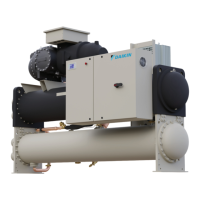
